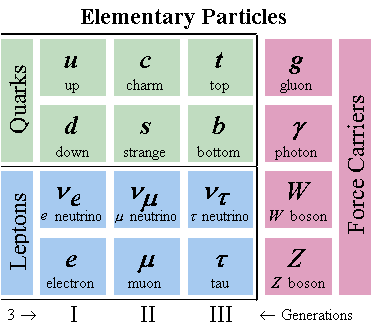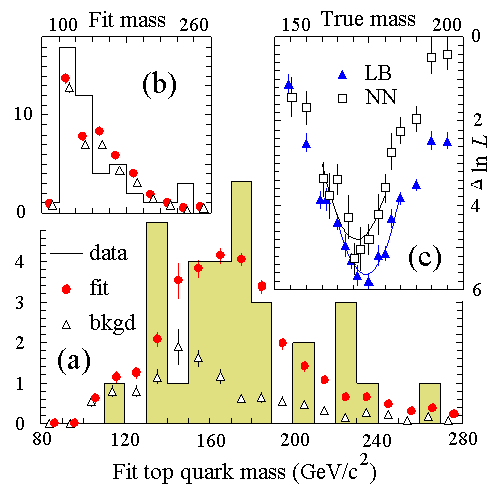
July 9, 1997
The top (t) quark was predicted by the Standard Model of particle physics, and observed in 1995 by the CDF and the DØ ("D-Zero") experiments at the Fermilab Tevatron. It completes the Standard Model "particle zoo" of 6 quarks, 6 leptons like the electron, and 4 force-carrying bosons like the photon (the quantum of light). This Table shows the zoo:

One of the reasons it took so long to find the top quark, and why we're interested in it, is its large mass M(t). The top quark is about as heavy as a gold nucleus. While the nucleus is a bag of >800 lighter quarks, the top quark is just one elementary particle, with fractional charge (+2/3) and zero size like the lighter quarks.
Here's how we measured the top quark mass. We started with a few trillion collisions of 900 GeV protons with 900 GeV antiprotons during 1992-1996 in the DØ detector (1 GeV is the kinetic energy that a 1 billion volt battery could give to 1 proton). We selected 90 events that are similar to what the Standard Model would predict if a top and an antitop quark are produced in the collision. Before we can detect it, each (anti)top quark decays to a b quark and a W boson. (In the Table, the b quark is the lightweight partner of the top quark, and the W boson is a heavy cousin of the photon). About 30% of the time one W decays to an electron or muon and a neutrino, while the other decays to a pair of quarks. In the D0 detector we carefully selected events with a signature for four quarks, one electron or muon, and one neutrino. Despite our care, this rare sample was still about 70% background, mostly production of a W boson together with other light particles. We needed to suppress the background further.
We accomplished this by using a figure of merit D that distinguishes top signal from background based on "soft" pattern recognition calculations of the type performed by neural systems. We designed these calculations so that events with higher D are more likely to be top, but they are not biased toward unusually large or small apparent top mass. For each of the 90 candidates, we calculated D and also the most likely top mass based on the directions and energies of the quarks and leptons (remember E = Mc2 from Einstein's special theory of relativity). The Figure below shows histograms of the calculated mass for (a) high D and (b) low D events, compared to the Standard Model predictions (red dots). Based on these histograms, part (c) of the Figure shows the relative likelihood of various top quark masses (for two different definitions of D).

Why did we try so hard to measure M(t) accurately? The argument is a bit involved, but here goes. As seen in the Table, the photon has two cousins, the W and Z bosons. (The photon is massless, but M(W) and M(Z) are about half of M(t).) Using the well measured fine structure constant (about 1/137), the muon lifetime (about 2.2 microseconds), and M(Z) as parameters, the Standard Model predicts M(W). Small (few %) corrections to the predicted M(W) arise from creation and absorption of "virtual" quarks and bosons. (Virtual particles live for so short a time that Heisenberg's Uncertainty Principle allows them to have any mass.) The quark correction depends on the mass of the top quark (because it is by far the heaviest). The boson correction depends on the log of the mass of a very special, as yet undiscovered particle, the Higgs boson. The Higgs would be the most important of all elementary particles because its interactions would explain the origin of all particle masses.
Here's the point. If we can use the Standard Model calculation to predict M(W), and if we can measure M(W) and also M(t) to determine the quark correction to M(W), the only unknown is the boson correction. Solving for that, we get a constraint on the Higgs mass (a modest one now, a better one in a few years). That will tell us where to search for the Higgs particle in crucial experiments planned for the next decade, both at Fermilab and at the new Large Hadron Collider in Europe. So, by measuring the top quark mass, we're helping to blaze a path that leads to understanding the origin of all masses.
For further information contact Prof. Mark Strovink, Univ. of California, Berkeley, email: strovink@lbl.gov
![]() Return to DØ Physics Summaries
Return to DØ Physics Summaries
Last modified: 7 Jul 97